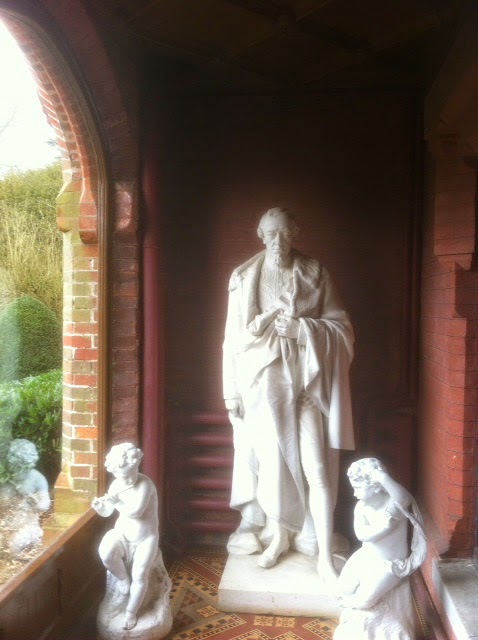I met Mike Adams when we were both fifteen and had just started a
catering course at Mabel
Fletcher Catering
College. He reminds me,
with no trace of bitterness that I refused to let him copy my work. I was a
young and ill-informed prat, but he got the last laugh, ending up cooking for
the Rothschilds, The Duke of Westminster and the Marlboroughs of Blenheim
Palace.
A painted panorama of Blenheim Palace
This is just the Gatehouse behind which is a large courtyard and the Palace itself
Mike's Apartment as Head Chef
View of the Gatehouse from the Palace. I told you the courtyard was big.
Mike recently showed us round the palace (the only non-royal,
non-episcopal palace in the country). It was a joy, marred only by Wei Wei and
his conceptual art. Had I wanted to see it I would have gone to the Tate or its
equivalent.
The Entrance Hall, (left side)
The Entrance Hall (right side) and a Wei Wei Chandelier
Mind you, we were given fair warning, having opted for an initial tour
before Mike took us elsewhere. The lady asked us (a group of twenty or so) were we interested in Wei Wei?" It was a
fair question and I gave a fair answer. "No," I said. I hadn't come here to see Wei Wei.
She looked shocked, but I didn't want to see pebbles artfully arranged,
nor pink and grey crabs, lopsided tables or his pictures defacing Blenheim's
Grand Library. My daughter was equally shocked. She poked me in the ribs. I had
been rude. I didn't see it. I'd been asked a question. I'd given an answer. And
we were shown his work not-withstanding, along with her interpretation of every
last piece, and how much she worshipped the air he breathed.
Sarah Jennings (The first Duchess of Marlborough) and her children. The Duke is the guy on the horse. This is where I was poked in the ribs by my daughter.
At last we were done and we wandered at will.
The Dining room.
Dining table
Dining table from other side
The palace was built between 1704 and 1711, and financed by a 'grateful
nation' for John Churchill, (the first Duke of Marlborough. His achievement was
striking. Blenhiem and a string of less well known victories were pivotal in
diminishing French power in Europe and later
the world. Had Louis XIV succeeded in the War of the Spanish Succession, Spain, and all
her New World Colonies would eventually have fallen into French hands, albeit
by proxy.
Louis XIV - the Sun King - the leggy brunette undefeated until Blenheim
Marlborough's lesser known achievement was keeping his armies well shod. Barges
laden with boots followed his armies wherever they went. It's hard to win
victories with raw feet and blisters.
A tapestry showing waggons carrying supplies. Marlborough thought things through.
Tapestry showing victory
A tapestry showing the French Marshal conceding defeat. Oh, to be the Duke surrounded by memories like these. I have a few Facebook likes by ex-pupils and a few well recieved stories : )
And my favourite - if you look closely you'll see the weaver has lost the plot. He's done so many horses he can't be bothered going out of his way for a dog - note the dog's hooves and how his legs (un-dog-like) mirror those of the horse
There is no doubt that John Churchill, First Duke of Marlborough helped shape the course of history in Britain's favour, but my God, Blenheim is gratitude over the top! Facing the house, some
distance away there's a Victory monument that makes Cleopatra's needle look
like…a needle.
Admittedly the Victory monument looks a bit needle-like from this distance, but it dominates the surrounding estate.
Then there's his own personal chapel.
The family private chapel
The pulpit. Pity the vicar who had to preach before Sarah Jennings sitting directly below him
A surprisingly modest altar, but then Jesus was a humble man
Look again at the small
altar and pulpit. Contrast it with his mausoleum. God gets a poor deal in
Blenheim, but then (unless you see John Churchill as His chosen instrument) He
hadn't just whupped the French, and set the British imperial ball rolling.
You might notice the Duke and Duchess as Caeser and Caeserina, and at the bottom in bas relief Marshal Tallard surrendering after the battle.
There is life outside the mausoleum
An £18 ticket allows you to revisit as often as you want in any given
year. It's a kind of Historical Time Share for those with delusions of
grandeur. The park alone is worth it, never mind the house. But just as you can have death by chocolate, you can suffer death by Blenheim. Too much of a good thing. But we'll look at the park next week.













































